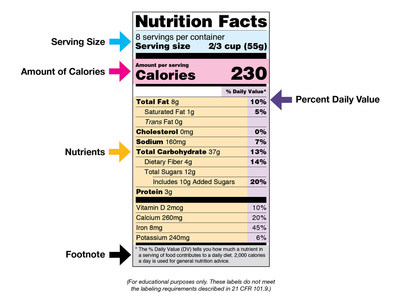SILVER SPRING, Md., Feb. 16, 2021 /PRNewswire-HISPANIC PR WIRE/ — Did you know that February is American Heart Month? According to the Centers for Disease Control and Prevention (CDC), heart disease is the leading cause of death in the United States. The U.S. Food and Drug Administration’s updated Nutrition Facts label is a tool that can help you make heart-healthy food choices.

- Servings Per Container shows the total number of servings in the entire food package or container. It is common for one package of food to contain more than one serving.
- Serving Size is based on the amount of food that is customarily eaten at one time and is not a recommendation of how much to eat.
- Calories refers to the total number of calories in a serving of the food.
- % Daily Value (%DV) shows how much of a nutrient in a serving of the food contributes to a total daily diet.
- Nutrients: the Nutrition Facts label can help you learn about, compare, and monitor the nutrients in many foods in your diet.
- Nutrients to get less of: saturated fat, sodium, and added sugars.
- Nutrients to get more of: dietary fiber, vitamin D, calcium, iron, and potassium.
Here’s how you can use the Nutrition Facts label to help you make healthy food choices, and reduce your risk of developing high blood pressure and heart disease:
- Check the serving size and the number of servings you eat or drink to determine how much of a nutrient you are consuming.
- Know your calorie needs. 2,000 calories a day is used as a general guide for nutrition advice. Learn your number at https://www.myplate.gov/myplate-plan.
- Use %DV to determine if a serving of the food is high or low in an individual nutrient and to compare food products (remember to make sure the serving size is the same). As a general guide:
- 5% DV or less of a nutrient per serving is considered low.
- 20% DV or more of a nutrient per serving is considered high.
- Limit sodium in your diet to less than 2,300 mg per day.
- Limit saturated fat in your diet to less than 10% of calories per day (e.g. 20 grams per day based on a 2,000 calorie daily diet).
- Limit calories from added sugars to less than 10% of total calories per day (e.g. 200 calories or 50 grams per day of added sugars based on a 2,000 calorie daily diet).
- Consume a diet rich in dietary fiber and vitamins and minerals, especially vitamin D, calcium, iron, and potassium, by choosing a variety of foods that are good sources of these nutrients since many people do not get the recommended amounts.
Visit the Nutrition Facts label Online for an interactive way to learn about the label: https://www.accessdata.fda.gov/scripts/InteractiveNutritionFactsLabel/
For more information on how to use the Nutrition Facts label to make informed food choices, visit www.fda.gov/nutritioneducation
Contact: Media: 1-301-796-4540 Consumers: 1-888-SAFEFOOD (toll-free)

Photo – https://mma.prnewswire.com/media/1431807/Nutrition_Facts_Label_Image_Highlighted.jpg
Logo – https://mma.prnewswire.com/media/585467/ucm519149_Logo.jpg
SOURCE U.S. Food and Drug Administration







